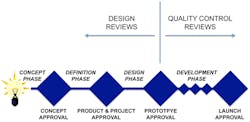Some companies consider their examination of prototypes to be a design review. It’s not; it’s a quality control review of an "as-built" product. If the prototype does not meet specs, the design team issues a change order to rectify the issue findings. And change orders take two days to two months to complete. So these late reviews do not reduce time to market, they extend it.
Perhaps the U.S. Government is to blame for this practice. Design reviews were first documented in Air Force MIL-STD-1521 and many commercial companies adopted and adapted them. MIL-STD reviews included those of prototypes and initial production-run products. All of this made sense, given the arms-length nature of government product managers from the contracted design and development companies.
In the commercial world, product design and its associated costs get frozen when 10 to 25% of the development budget has been spent. Prototypes-to-spec, most often, are built after this point in the process. Finding a defect then means a formal fix cycle must start, not a design change. Of course, developers need to review as-built products, and always will. Design reviews, however, should greatly reduce the number of defects that must be fixed when discovered in a quality-control review.
Before the era of 3D and solids/surface modeling, best practice companies assembled independent groups of developers to sit with development teams and review product designs. Everyone spoke the language of printed drawings, including manufacturing personnel. The teams discovered and fixed many defects and glitches before the prints were released. Although solids and surface modeling brought many design and engineering advantages, it also eliminated the common cross-functional language of printed drawings that had been used for decades. More and more, design reviews fell later in the product-development cycle because at that point, the team could communicate in another shared language, the prototype.
There are two primary impediments to earlier design reviews in this day and age. The first is meetings. There are so many management and control meetings that the thought of adding more is too much, even if they might be more worthwhile than some meetings currently scheduled. Of course a meeting is needed when the first working products are built, but generating excitement for earlier meetings is practically a nonstarter.
The second impediment is that the digital era seems to have reduced our desire to communicate in-person. Research shows that the younger generations have difficulties ending a phone conversation because of the stress created by deciding when to say good-bye. Twitter, for example, has become a communication outlet for some because they feel more comfortable letting it strictly enforce the length of the communication. These behaviors are gradually making their way across generations as the digital era overtakes almost every aspect of person-to-person interaction. Going into a meeting to critique the designs of others face to face is much more stressful than deciding the length of a phone call. Reviewing the inanimate prototype is seemingly easier, even though it was designed by someone in the room. Leadership, and perhaps some communication and conflict resolution training, can help overcome these obstacles.
The current fly-in-the-ointment for the timing of design reviews is 3D printing. These 3D-printed objects are increasingly becoming true prototypes. In the next few years, as this technology matures and rapid tooling and rapid manufacturing also come of age, these prototypes will be sold to customers. Rapid prototypes will be the digital-era definition of full form-and-function prototypes. Within a few years, all companies will widely use 3D capabilities. It will reset the industry standards for design/development and time to market. In that new era, finding a defect in a rapid prototype will be analogous to finding fault in an as-built product review today.
Industries should soon realize that rapid prototyping really improves the process of ferreting out faults and defects in designs and processes. When rapid tooling and manufacturing become the new global standard, however, companies will be wishing they had already the mastered the process of reviewing digital designs.
About the Author
Bradford Goldense
Contributing Technical Expert
Bradford L. Goldense is founder and president of Goldense Group, Inc. [GGI] (www.goldensegroupinc.com), a consulting, market research, and education firm focused on business and technology management strategies and practices for product creation, development, and commercialization. He has been an adjunct faculty member of the graduate engineering school at Tufts University's Gordon Institute for 19 years. Goldense is a Certified New Product Development Professional [NPDP], a Certified Manufacturing Engineer [CMfgE], a Certified Computer Professional [CCP], and is Certified In Production & Inventory Management [CPIM]. He holds over 200 registered copyrights and is a recognized subject-matter expert, including appearances on PBS and CNBC. He has consulted to over 250 companies and over 750 manufacturing locations on four continents since founding GGI in 1986. Goldense holds an MBA in Accounting from the Cornell Johnson School and a BSCE from Brown University. For more information, please see Brad's LinkedIn profile or visit GGI's home page.


